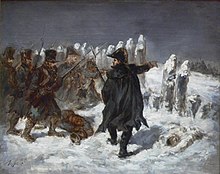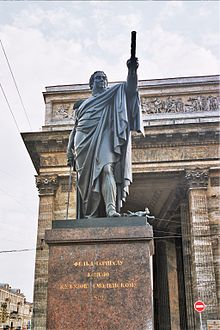French invasion of Russia order of battle
After a whole day of preparation by Morand and Eblé, the invasion commenced on Midsummer, 24 June 1812 with Napoleon's army crossing the river.
[2] Within a few days, almost half a million men from this multinational army - split up into five columns - crossed the river Neman and entered the Russian Empire.
[9] Marshal Joachim Murat, his brother-in-law, under King of Naples, followed with (21,000) Napoleon to Vilnius and Vitebsk It followed behind the central force and (81,000) crossed at Pilona and avoided Vilnius Napoleon's brother Jérôme Bonaparte King of Westphalia (62,000) crossed the Niemen near Grodno on 1 July,[17] and moved towards Bagration's (second western) army.
With French forces moving through different routes in the direction of Vitebsk, a first major engagement took place on 25 July at the Battle of Ostrowno.
In addition, National Guard units had been conscripted for full military service defending the frontier of the Duchy of Warsaw.
Anthony Joes in Journal of Conflict Studies wrote that:[41] Figures on how many men Napoleon took into Russia and how many eventually came out vary rather widely.
Whatever the accurate number, it is generally accepted that the overwhelming majority of this grand army, French and allied, remained, in one condition or another, inside Russia.Minard's infographic (see below) depicts the march ingeniously by showing the size of the advancing army, overlaid on a rough map, as well as the retreating soldiers together with temperatures recorded (as much as 30 below zero on the Réaumur scale) on their return.
In the third line were the 36 recruit depots and militias, which came to the total of approximately 161,000 men of various and highly disparate military values, of which about 133,000 actually took part in the defence.
















